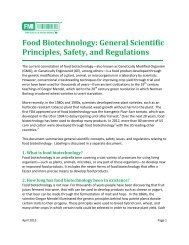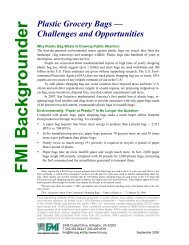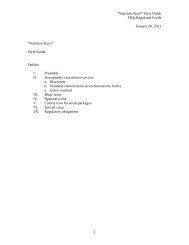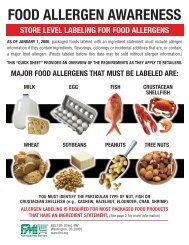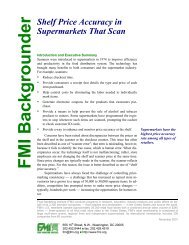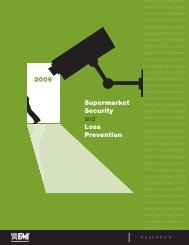Low-Level Use of Antibiotics In Livestock and Poultry
Low-Level Use of Antibiotics In Livestock and Poultry
Low-Level Use of Antibiotics In Livestock and Poultry
You also want an ePaper? Increase the reach of your titles
YUMPU automatically turns print PDFs into web optimized ePapers that Google loves.
<strong>Low</strong>-<strong>Level</strong> <strong>Use</strong> <strong>of</strong> <strong>Antibiotics</strong> in <strong>Livestock</strong> <strong>and</strong> <strong>Poultry</strong><br />
FDA, CDC <strong>and</strong> USDA all agree that antibiotics are as critical in<br />
treating bacterial infections in animals as in humans. Government<br />
scientists also acknowledge the relationship between the use <strong>of</strong><br />
antibiotics in food-producing animals <strong>and</strong> the emergence <strong>of</strong> drugresistant<br />
bacteria that can infect people.<br />
6. Where do animal health experts st<strong>and</strong> on this issue<br />
Antibiotic resistance is a major concern among drug manufacturers <strong>and</strong><br />
veterinarians. The Animal Veterinary Medical Association (AVMA)<br />
notes that “evidence is accumulating to support the hypothesis that<br />
antimicrobial resistance in animals can result in the transfer <strong>of</strong> resistant<br />
bacteria . . . or genetic determinants to humans through the food supply<br />
by direct animal-to-human contact or indirectly through the<br />
environment.” 9 <strong>In</strong> May 2003, AVMA issued a position statement<br />
reading, in part, “The AVMA supports a national, coordinated, <strong>and</strong><br />
appropriate response to the issue <strong>of</strong> antimicrobial resistance in bacteria<br />
that includes an open or public FDA approval process that is rigorous<br />
<strong>and</strong> that includes an assessment <strong>of</strong> food safety to approve animal health<br />
products for use in animals.” AVMA, the Animal Health <strong>In</strong>stitute (AHI)<br />
<strong>and</strong> other groups are now developing guidelines for the prudent use <strong>of</strong><br />
antibiotics in farm animals.<br />
At the same time, some animal health experts argue that most <strong>of</strong> the<br />
antibiotics given to farm animals are to prevent or treat illnesses, <strong>and</strong> that<br />
relatively little is administered to promote growth. AHI says each ton <strong>of</strong><br />
animal feed contains just four to 25 grams <strong>of</strong> antibiotics, with only 13<br />
percent <strong>of</strong> all antibiotics in animal feed used for growth promotion. AHI<br />
also cites declines in the incidence <strong>of</strong> drug-resistant Salmonella <strong>and</strong><br />
Campylobacter in humans since 1996, pointing to data from CDC’s<br />
National Antimicrobial Resistance Monitoring Systems (NARMS). 10<br />
<strong>In</strong> 2001, a study by the European Federation <strong>of</strong> Animal Health<br />
concluded that humans consumed 65 percent <strong>of</strong> all antibiotics<br />
administered in the European Union in 1999, versus 35 percent for<br />
animals. The study found that only 6 percent <strong>of</strong> all antibiotics took the<br />
form <strong>of</strong> growth promoters in animal feed. It also claimed that this use <strong>of</strong><br />
antibiotics fell by 50 percent between 1997 <strong>and</strong> 1999. Reacting to these<br />
findings, the Animal <strong>and</strong> Plant Health Association (APHA) asserted that<br />
the use <strong>of</strong> antibiotics in farm animals is, at most, only a “very small<br />
contributing factor to the problem <strong>of</strong> antimicrobial resistance,” according<br />
to Declan O’Brien, the group’s director. 11<br />
7. What is the position <strong>of</strong> consumer advocates<br />
The Union <strong>of</strong> Concerned Scientists (UCS) supports reducing the use <strong>of</strong><br />
antibiotics in food animals, saying the drugs produce benefits that “are<br />
FDA, CDC <strong>and</strong> USDA all<br />
agree that antibiotics are<br />
critical in treating<br />
bacterial infections in<br />
animals as well as<br />
humans.<br />
‘Each ton <strong>of</strong> animal feed<br />
contains just four to 25<br />
grams <strong>of</strong> antibiotics, with<br />
only 13 percent <strong>of</strong> all<br />
antibiotics in animal feed<br />
used for growth promotion.’<br />
— Animal Health <strong>In</strong>stitute<br />
9 AVMA, “Judicious Therapeutic <strong>Use</strong> <strong>of</strong> Antimicrobials”<br />
(www.avma.org/scienact/jtua/default.asp).<br />
10 See footnote 8.<br />
11 APHA press release, “Antibiotic <strong>Use</strong> in Farm Animals Does Not Threaten<br />
Human Health, a New Study Suggests,” June 13, 2001.<br />
Food Marketing <strong>In</strong>stitute 4




